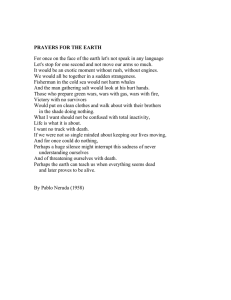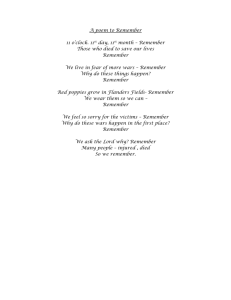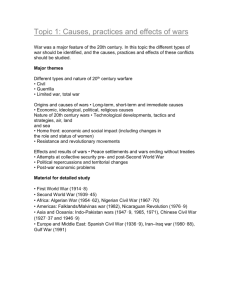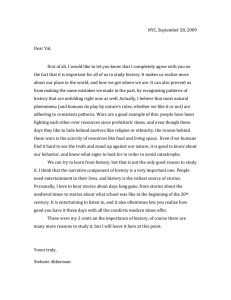Rebooting the Discussion of Air Power and Small Wars
advertisement
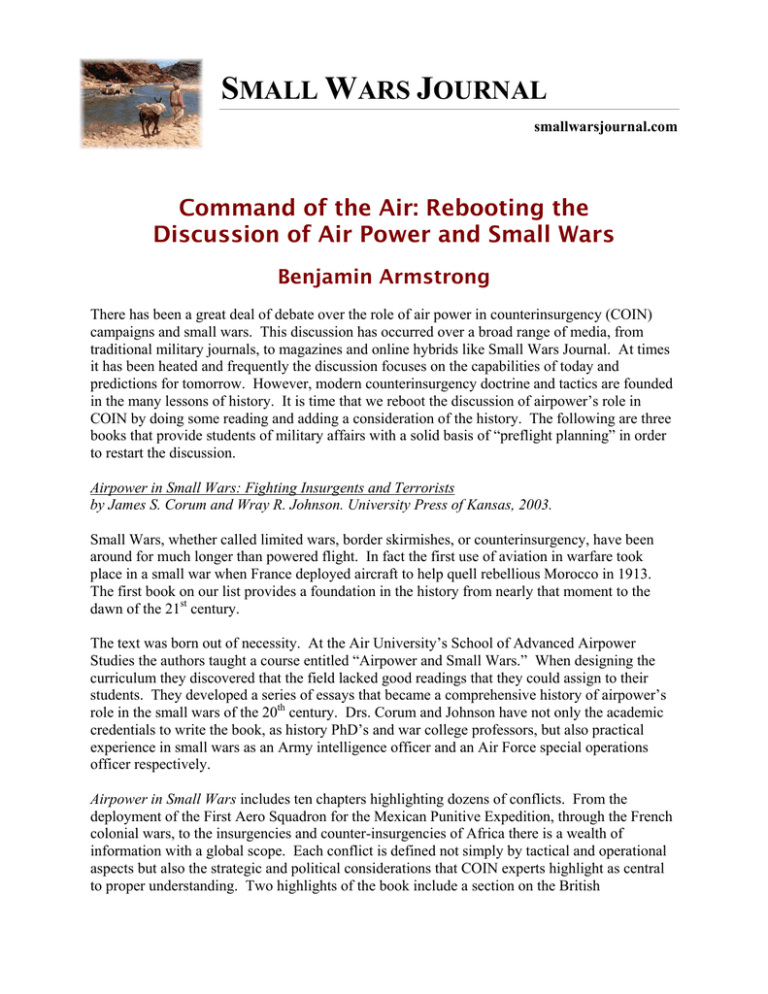
SMALL WARS JOURNAL smallwarsjournal.com Command of the Air: Rebooting the Discussion of Air Power and Small Wars Benjamin Armstrong There has been a great deal of debate over the role of air power in counterinsurgency (COIN) campaigns and small wars. This discussion has occurred over a broad range of media, from traditional military journals, to magazines and online hybrids like Small Wars Journal. At times it has been heated and frequently the discussion focuses on the capabilities of today and predictions for tomorrow. However, modern counterinsurgency doctrine and tactics are founded in the many lessons of history. It is time that we reboot the discussion of airpower’s role in COIN by doing some reading and adding a consideration of the history. The following are three books that provide students of military affairs with a solid basis of “preflight planning” in order to restart the discussion. Airpower in Small Wars: Fighting Insurgents and Terrorists by James S. Corum and Wray R. Johnson. University Press of Kansas, 2003. Small Wars, whether called limited wars, border skirmishes, or counterinsurgency, have been around for much longer than powered flight. In fact the first use of aviation in warfare took place in a small war when France deployed aircraft to help quell rebellious Morocco in 1913. The first book on our list provides a foundation in the history from nearly that moment to the dawn of the 21st century. The text was born out of necessity. At the Air University’s School of Advanced Airpower Studies the authors taught a course entitled “Airpower and Small Wars.” When designing the curriculum they discovered that the field lacked good readings that they could assign to their students. They developed a series of essays that became a comprehensive history of airpower’s role in the small wars of the 20th century. Drs. Corum and Johnson have not only the academic credentials to write the book, as history PhD’s and war college professors, but also practical experience in small wars as an Army intelligence officer and an Air Force special operations officer respectively. Airpower in Small Wars includes ten chapters highlighting dozens of conflicts. From the deployment of the First Aero Squadron for the Mexican Punitive Expedition, through the French colonial wars, to the insurgencies and counter-insurgencies of Africa there is a wealth of information with a global scope. Each conflict is defined not simply by tactical and operational aspects but also the strategic and political considerations that COIN experts highlight as central to proper understanding. Two highlights of the book include a section on the British development of “air control” or “air policing” in their colonial conflicts between the World Wars (including analysis counter to the conventional wisdom) and a reassessment of American airpower in South Vietnam from the small wars perspective. Throughout the book the history is not only fully annotated, indexed, and sourced but also engagingly written. The final chapter should be mandatory reading for today’s pilots and students of COIN. The authors present eleven lessons that define the successful use of air power in small wars, counterinsurgencies, and anti-terrorist operations. These lessons are founded in the historical principles of counterinsurgencybut consider the strengths and weaknesses of modern technology. To list only a few highlights does a disservice to the work. Airpower in Small Wars provides a solid foundation of the history that should underpin the 21st century discussion of the role of air power. Air Commandos Against Japan: Allied Special Operations in World War II Burma by: William Y’Blood, Naval Institute Press, 2008. In 1943 two young Army pilots were called to the newly built Pentagon for a meeting with General “Hap” Arnold, Commanding General of the Army Air Forces. The secret assignment given to Colonels John Alison and Philip Cochran was codenamed Project 9 and resulted in the creation of one of the most innovative air units of the Second World War, the 1st Air Commando Group (ACG). By the end of the war there were three ACGs created and deployed to the China/Burma/India Theater (CBI) and the South Pacific. These groups marked the creation of the first integrated air units designed to support allied troops behind enemy lines. The group contained fighter squadrons, light bombers, small liaison aircraft, transports, gliders, and even the first helicopters. While the ACG’s spent large portions of the war broken up, misallocated to support traditional missions, they carried out two significant operations in the CBI. In the spring of 1944 the 1st ACG carried the “Chindits,” irregular warfighters under British General Orde Windgate, deep behind enemy lines and supported them completely by air. The second operation, carried out by the 2nd ACG, was the longest fighter mission of the war. Forty P-51s struck the Japanese Airfield at Don Muang, Thailand in 1945, demonstrating the ability of tactical aircraft to conduct precise strategic strike missions. William Y’Blood, author of several airpower histories and a historian with the Air Force Historical Center, drew nearly 100% on primary source material for the book. His battle history is not just lists of names, dates, and places, but tells a great story that has long been ignored as a backwater of history. In a great loss to aviation history, the author passed away on completion of the manuscript. His friend and fellow USAF historian Jack Neufeld edited the work and guided it through the publication process. Air Commandos Against Japan is not directly about counter-insurgency, and the operations certainly took place during a “big war.” However, the history is still instructive. It demonstrates the viability of hybrid air units, purpose built for the kinds of operations that occur in small wars. In the ACG’s the liaison squadrons of light planes which conducted casualty evacuation, small unit battlefield logistics, and reconnaissance, were just as important as the fighter squadrons that included several aces. The book also highlights the cultural and institutional challenges that Page 2 of 4 smallwarsjournal.com © 2009, Small Wars Foundation purpose built units like the Air Commandos face. Constantly raided for pilots and aircraft by senior commanders who did not understand their purpose, they infrequently operated as designed. Despite this the number of innovative methods developed by the Air Commandos is startling. They were leaders in close air support, vertical envelopment, and combat search and rescue, all important elements of today’s counterinsurgency airpower. The Air Force Role in Low-Intensity Conflict by: David J. Dean, Air University Press, 1986. Published in October, 1986 The Air Force Role in Low-Intensity Conflict doesn’t just recount history; the book itself is a piece of history. Written during the Cold War, as the militaries of the world began to understand that a global war between the two superpowers was less likely than numerous small proxy conflicts, the book was meant to make policy suggestions for the world of two decades ago. However, the lessons gleaned by then Colonel Dean are just as applicable today as they were in the mid-eighties, maybe even more so. The book is made up of seven chapters. It first provides a brief background in the history of small wars and air power, focused on the British Air Policing experience we have already discussed, as well as the United States Air Force’s organizational problems when trying to address small wars. Following this background the heart of the book analyzes the poor results of an American attempt to assist the allied Moroccan Kingdom during their counterinsurgency against the Polisario in the early eighties. This assistance came through an attempt by the United States Air Force to provide support to the Moroccan Air Force, an attempt which encountered numerous unexpected challenges. The final two chapters of the book outline lessons from the experience with the Moroccans and better ways for the USAF to approach small wars. The USAF’s expertise in high technology and precision weapons was hard to translate into practicable assistance to third world Air Force like Morocco’s. The expert pilots sent as advisors didn’t speak the language or understand the culture, and had most of their experience in more advanced fighters than the F-5’s used by their students. These challenges, combined with a short-fuse planning cycle and short length of the mission, resulted in little real help for the allied Air Force. It is in the first chapter, outlining the USAF’s organizational and definitional challenges in approaching what was then called low-intensity conflict, and in the last chapters with policy recommendations, that we can clearly see the Air Force’s struggle with small wars. From the outside it appears that few of the organizational issues discussed have been addressed in the intervening decades, and even fewer of Colonel Dean’s recommendations have been accepted. Because of this, many of his policy suggestions continue to hold water today. They echo the suggestions of the other books discussed in this essay, of the importance of numerous types of aircraft, purpose designed organizations, and operational flexibility. Air power has a central role to play in small wars and counterinsurgency operations. Throughout history it has been a vital facilitator of operations. Heliborne forces have returned initiative and speed, frequently the strengths of insurgent forces, to the counter-insurgent. Airborne reconnaissance provides the warfighter on the ground with superior knowledge and intelligence, Page 3 of 4 smallwarsjournal.com © 2009, Small Wars Foundation normally associated with local or indigenous forces. Modern aerial strike capabilities provide the ability to bring massive violence to bear in precise ways never imagined before. Despite these truths, air power requires organization, the proper mix of aircraft, and doctrinal development to increase its effectiveness and ability to provide combat support to the warfighter on the ground. A review of applicable history and literature will help the air power theorists and practitioners of today and tomorrow to hone their blades for the fight. Lieutenant Commander Benjamin “BJ” Armstrong is a Naval Aviator who has served as an Amphibious Search and Rescue and Special Warfare Pilot and an Advanced Helicopter Flight Instructor. He holds a MA in Military History from Norwich University and has written on air power and naval history. His articles and reviews have appeared in numerous journals including The Journal of Military History, Strategic Insights and Air & Space Power Journal’s Chronicles Online. This is a single article excerpt of material published in Small Wars Journal. Published by and COPYRIGHT © 2009, Small Wars Foundation. Permission is granted to print single copies for personal, non-commercial use. Select non-commercial use is licensed via a Creative Commons BY-NC-SA 3.0 license and per our Terms of Use. We are in this together. No FACTUAL STATEMENT should be relied upon without further investigation on your part sufficient to satisfy you in your independent judgment that it is true. Contact: comment@smallwarsjournal.com Visit www.smallwarsjournal.com Cover Price: Your call. Support SWJ here. Page 4 of 4 smallwarsjournal.com © 2009, Small Wars Foundation
